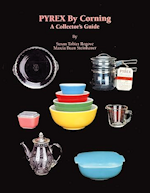Hunting For Collectible Pyrex Kitchenware
|
» Hunting: Where To Look
» Diligence: Stay Calm » Negotiation: Getting The Best Deal |
Although learning about its history and acquiring a variety of nice pieces is a large part of the hobby of collecting vintage Pyrex kitchenware, many will tell you that what keeps it most engaging over time is "the thrill of the hunt". Seeking out new pieces for your collection and making those "lucky finds" are a big part of the fun.
It doesn't take long for most determined collectors to find, exploit, and in some cases exhaust the venues for vintage Pyrex in their local area. And, although the vast selection available on eBay remains a prime source for many, collectors can quickly become disenchanted with the unreasonable pricing often found there, with the inability to conduct a "hands-on" inspection, and with the receiving of pieces in worse-than-expected condition.
Local Venues
Garage/yard/estate sales may seem like a good idea, but the better part of a day can be spent going from one to the next to the next without much to see. Additionally, those not arriving early to such events will likely miss out on whatever was available.
If you do manage to find something you want, complete the transaction and secure your purchase in your vehicle. Asking the seller or sale manager to hold your selection while you continue to shop may end in frustration if you return to pay only to learn your find has been mistakenly given to another shopper.
Expanding Your Search Radius
The next step, then, is to search for opportunities further from home. This obviously requires time and expense, but, with careful planning, you can make the most of a day trip or some other, scheduled out-of-town travel. Even in these days of expensive auto fuels, you may be able to enjoy a day exploring destinations as much as an hour's drive away for around $20 in gas money.
Internet search engines and their map features are the place to start. Choose a locale to which you plan to travel by entering the city and state names into the search box, and then zoom in to a 10-mile radius view. Next, find potential vendors by, one at a time, typing terms like "antiques", "antique stores", "flea markets", "consignment stores", and "thrift stores" into the search box. Results of each will appear on the map as numbered dots which correspond to a listing diplayed alongside the map. Clicking and dragging the map slightly, or zooming in may also generate additional nearby results. Change the map style to a traffic view, then select Print from the menu to make hard copies as desired.
Your expectations of finding better pieces should coincide with the category of vendor.
Since a fair number of online sellers apparently make a habit of regularly browsing thrift establishments to find all manner of items they think will turn a profit, it's usually a matter of happening to make a lucky find on any given day at those types of stores.
Indoor or permanent flea markets represent a middle ground in that their bigger vendors frequent or are often involved in the handling of estate sales, meaning the Pyrex they do acquire for resale is often in decent shape and the prices are usually negotiable.
Nicer pieces are often to be found at antique stores and antique malls, but typically at higher asking prices.
Consignment store finds can be tricky. The format followed by most is to only reduce the price of items the longer they remain unsold, usually by increasing a percentage discount at 30-day intervals. You may, therefore, find yourself pressed to pay more than you'd like rather than risk finding the item gone before the next discount interval passes. Price tags are marked according to date of arrival, and there should be a discount schedule posted.
If you own some of the popular collector guide books, bring them with you to help with identification. Another powerful tool is the eBay® smartphone app, which can search completed sold listings and help you determine average current selling prices.
Scouting A Location
The name of a business can often be a tip as to what to expect. Store names like "Antiques and Interiors" or "Antiques and Gifts" frequently mean you're going to find more items of the latter category in each. You can also safely exclude, in most cases, the search results that appear to be strictly collectibles shops, such as those for comic books or baseball cards.
Try also to determine from your map those results which are located in residential areas. These listings are often the homes of antique dealers who have no actual retail storefront to visit. Bird's eye and street views on internet search engine maps can be helpful in showing you the location and surroundings.
Often, map listings will include a website URL if the vendor has one, where you may be able to view photos and find out operating hours. It may be prudent to phone the most promising-looking vendors before your trip to make sure they will be open when you arrive. There may also be links to customer reviews, but bear in mind that, good or bad, they may not necessarily be truthful nor accurate representations of the vendor.
Most dealers these days will have a facebook presence. Pages typically have hours of operation listed and a map for directions. Browse the photo section of such pages to get a feel for the general types of offerings, or the lack thereof. Bear in mind that photos are a snapshot of moments in time, so that which you see of interest may be long gone. Photo posting dates are therefore worth noting.
Once you do arrive in your chosen Pyrex hunting locale, use the map application on your smartphone to help navigate the area. By applying the same search criteria in your phone's map app, you may also find additional results not on your previously-generated computer map. The biggest plus here, however, is that your phone can also function as a GPS while in the map app, letting you know in real time your proximity to your chosen stop. Keep your eyes on the road, though, and pull over in a safe spot before checking your position.
Since the areas you visit may be unfamiliar to you, remain alert and aware of your surroundings. Some vendors may be located in less than completely safe locations, and, since it's likely you'll be carrying cash for a potential purchase, you'll want to be extra careful.
Many times, in an unfamiliar locale, you won't know the potential of a given vendor until you walk in the door. Suffice it to say that if all you see upon entering are ultra-expensive interior decor pieces or, conversely, nothing more than yard sale junk, you're better off not wasting either your or the proprietor's time. And, if upon entering a venue, you are met with the overwhelming aroma of potpourri, you should probably lower your expectations of Pyrex success there.
At some places, there may be publications in the form of pamphlets or newspapers, available for the taking, listing local area antique vendors. Look for them in racks near the door or on the counter.
Pay attention for sale signage at any establishment you visit. Individual vendor booths may have percentage discounts posted for all or parts of their inventory. Be sure to bring it to the cashier's attention when checking out, as they often do not keep close track of each dealer's sales promotions.
At many venues, you may find your efforts to negotiate a better price roadblocked by an established house policy. It is not uncommon for managed antique malls or flea markets to set a price threshhold below which they will not consider offers or phone their absentee sellers with offers, typically on items priced at $20 to $25 or less.
Another roadblock to a reasonable price negotiation can occasionally be found courtesy of eBay. Some dealers will search there, print out "comparable" listings, and display them next to their items. As one might guess, they typically choose the most expensive example, regardless of condition or an actual, successfully completed sale.
About Buying Sets
In your search for vintage Pyrex, you'll often find bowls being offered for a single price for a set of three or four. They'll usually be in a nested stack taped together with a criss-cross of clear packing tape, ostensibly to prevent them from being separated. But the tape also precludes your ability to assess the condition of all but the largest bowl. You could risk removing the tape, but, as you know: You break it, you buy it. You could ask the proprietor to remove the tape for you-- and they most likely will-- but don't be surprised to see some scratched up bowls more often than not.
Dealers like selling sets because they believe that's what people want, and also because they believe sets should command a higher price (and thus a higher profit) over and above the individual bowls separately.
People do want sets, but they don't want to pay a premium for pieces of marginal quality, nor do they want to be forced to buy damaged bowls in order to get the one or two in good shape they want. The sets you want and will be the happiest with in the long run are those you assemble yourself, which gives you the option of paying what you want for pieces in the condition you desire. Patience, in this case, is its own reward.
If you make enough of these kinds of trips, memories of the places you visit can tend to blur together. Keep notes on each of your stops, and take photos if you can. Documenting your hunting trips will also help you remember to exclude the unproductive venues from your itinerary should you return to the area in the future.
Hunt for Pyrex efficiently. Bringing along a friend, spouse, partner or significant other who also enjoys collectible vintage kitchenware-- or any other collectible in a similar vein for that matter-- can make your Pyrex hunting trip more enjoyable and productive. At many venues, there is far, far more to see than just Pyrex, so it may take quite a bit of time to check every aisle, booth, bay, or shelf by yourself. If you can "divide and conquer" at each stop, with each person looking out for the other's favored items as well as their own, it will mean you will be able to visit more places in a single day's hunting. If necessary, make your own "picker's flyer" to show to vendors who might have what you're seeking, but perhaps not currently on display.
Keep an eye out for orphaned Pyrex lids, especially those for oval and Cinderella round casseroles. As of 2019, oval casseroles have been discontinued for 40 years and Cinderella round casseroles for 33 years. Clear lids can often be picked up for just a dollar or two, and can come in handy for when you find that otherwise nice but missing-its-lid dish. Be sure to look them over well and feel the edges for chips and flea bites.
In a similar vein, if it's promotional pieces which interest you, try to familiarize yourself with the accessories with which they were originally sold. Cradles, candle warmers, trivets, underplates, and chip & dip bowl brackets all provide an extra-special something when used to display your vintage promos.
Another consideration is that several promos had decorated lids. You may find a promo dish married to a plain lid or to one different from that with which it originally came. You'll need to decide if finding the right lid later is worth the trouble and/or extra expense.
As your collection grows, it will become more difficult to remember what you already have vs. what you're looking for. Obviously, there are some things you know you'll want the moment you see them. But sometimes the odd pieces you need to complete the various sets you're building don't come readily to mind. In that case, make out a "need" list to carry with you, and include the pattern names and models numbers of the specific pieces you are missing and wish to acquire. You may also be in need of lids for dishes that are missing them; add their model numbers to your list as well.
Pyrex Hunting Checklist
- Full tank of gas
- Maps of potential destinations
- Cash - in a variety of denominations
- LED pocket flashlight (with fresh batteries) - to check for damage
- Collector's guide books - to help identify and estimate value
- Your need/want list
- Cell phone
- GPS or smartphone GPS app - for driving directions
- Digital camera or smartphone with camera
- Pen & notepad
- Snacks & drinks
- Comfortable footwear
- Hunting buddy - two sets of eyes are better than one
Being Diligent
So, let's say you've just found a piece you've been wanting for a long time. And it has a tag on it with a price you're more than willing to pay. Or maybe more than you'd like to pay. Or no price tag. But you really want it.
The biggest cause of buyer's remorse is a rush of adrenalin, which can cloud your judgement and blind you to flaws, especially if the item you find happens to be obviously underpriced. So, stop. Take a breath. Exhale. Now, let's make sure your excitement isn't going to get the better of you.
Check its condition. Feel the edges for chips. All the edges. Is the lid chipped or scratched? Is it the correct lid for the pattern or promo? Look under the dish handles and at the bottom corners for rub wear and paint loss. You brought your pocket flashlight, didn't you? If lids are taped to dishes, do what you can to inspect them for chips as best you can without risking damage. Look closely for scratches in the paint. All over. Look closely at the decoration for damaged areas. Very closely. Does it meet your standards for condition? No? Put it down and keep moving. If it does, then proceed to Negotiating A Price.
If you (or a helful store employee) take some of your selections to the counter to be held while you continue to shop, ask that the items not be wrapped up until you are ready to pay. This will be your last opportunity to check condition, and in probably the best lighting the venue has to offer. If the sales process includes removing taped-on price tags for vendor record-keeping, make sure those tags aren't concealing undesirable damage. In fact, you may want to remove them yourself if the store doesn't, just to be sure.
There is nothing more disappointing than to get your new finds home to only then discover damage that would have affected your purchase decision.
Negotiating A Price
Some people prefer the dentist's drill over haggling for a better price, but it really isn't all that painful. For most antiques, collectibles, or any used item in general, the price on the tag is just a starting point. You should never feel bad about asking-- in a courteous manner, of course-- for a better price. The worst that can happen is being told no, and hopefully as courteously as you asked.
Some examples:
Could you do any better on this one/both of these?
What's your best price on this one?
Sometimes just broaching the subject is all that's required; most sellers would rather be perceived as accommodating than as hard to do business with.
What's today's special price on these?
Keep your ears open. If you overhear another shopper ask for and successfully receive a better price, your odds of doing the same are good.
Items marked "firm". Sometimes firm doesn't necessarily mean non-negotiable. It may just mean "don't insult me with a lowball $5 offer on an item priced $20". Occasionally, "firm" prices can be softened when purchasing multiple items.
Price tags can actually hold clues to a seller's willingness to negotiate. Setting prices according to round figures is a natural tendency. Although the big box retail stores like to think they're using marketing psychology effectively, we all know that $99.99 is still one hundred dollars. So, when you see a price like $11, $17, $22, or $33, you can be fairly sure the seller has built a pre-set margin for negotiation into that marked price, and will likely take $10, $15, $20, or $30, respectively, without so much as the bat of an eye. All you have to do is ask. Nicely. You may be surprised to get an even better price than those if the seller is motivated to move the item.
No price tags can mean a couple of things. The first, and the one you should be most hopeful of, is that everything's negotiable. The second is that the seller has decided to quote prices only upon request, and probably wants to size up your ability to pay a price higher than lower before doing so. If the latter case, it's most important that you know values, and that you stick to your guns (and your budget). The seller may need to pay their rent, or they may just need a few dollars in cash to buy lunch that day. You could very well have that new piece for your collection for just the price of a footlong sub sandwich.
Happy Hunting!











